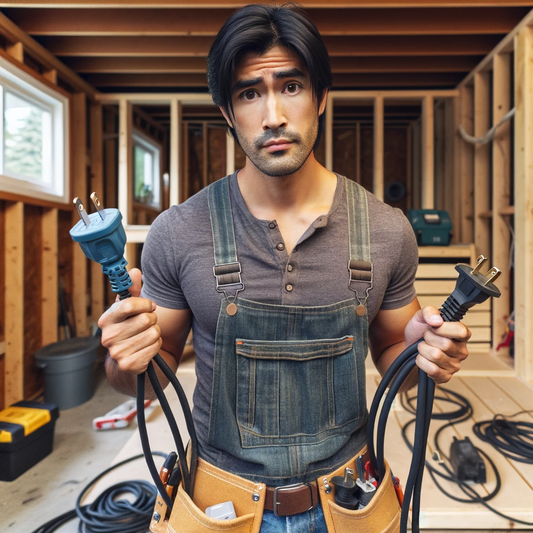Doesn’t the thought of assembling your very own sauna in your home or backyard get your pulse racing with excitement? Well, it should! But there’s more to saunas than just relaxation and detoxification. There’s an entire science that goes behind powering up your new infrared sauna. The convenience of a pre-wired electrical box allows for easy installation, simply plugging into an existing 220V outlet. Additionally, the plastic feet on the sauna make it easy to move across different types of flooring, such as floor or carpet. So, let’s dive into the labyrinth of sauna power consumption, and unearth the essentials of electrical requirements that ensure your sauna heats up to perfection while prioritizing safety. The power cord is crucial in this setup, and consulting a certified electrician can help avoid electrical issues.
What’s the deal with sauna power systems—hardwired or not?
The decision to hardwire or not is primarily dictated by the size and the type of the sauna you fancy. If you’re thinking of going all out with a large, traditional sauna that replicates the heat of an arid desert, you’re most certainly looking at a hardwired electrical system. Smaller, infrared saunas that maintain a more moderate climate can usually operate with simple plug-in connections. A study in the Energy and Buildings journal (2014)[1] sheds light on this subject. Traditional saunas, due to their voracious appetite for power, demand hardwired electrical systems and the finesse of professional electricians.
Should I hire an electrician?
In my experience of sauna installations, engaging the services of a licensed electrician is always a prudent move. On the surface, it may look like a cost-saving measure to do everything yourself, but you’re dealing with electricity here—the stakes are relatively high. If your sauna requires a hard-wired installation, then you must have a certified electrician handle this.
The finer aspects of sauna installations demand the tact of a skilled electrician who is well-versed with the ins and outs of safety and local building codes. Don’t just take my word for it, the Electrical Safety Foundation International[2] lays serious emphasis on hiring licensed electricians for home improvement tasks that involve electricity.
Can I use my wall outlet?
Maybe. If you’re opting for a smaller, usually infrared, home sauna, you might get away with running it on a standard 120-volt, 15-amp electrical outlet. But tread lightly if you’ve got a bigger sauna. They typically warrant a dedicated electrical circuit that falls in the range of 220- to 240-volt, 20- to 60-amp. This information was gleaned from a study in the Journal of Light Construction (2007)[3]. It’s a common mistake to plug a high-requirement appliance like a large sauna into a standard outlet. This can overload your power circuits and pose serious electrical hazards.
What’s the deal with special sauna outlets?
Although smaller, portable saunas or at-home infrared saunas may seem content with a standard outlet, it’s a whole different ball game for larger saunas. They demand more powerful heaters that gulp electricity, needing higher amperage than what standard outlets can manage. This is where dedicated circuits step in with special outlets that typically range from 220 to 240 volts to safely power your relaxation haven.
For the most enchanting sauna experience, remember safety is paramount, and functionality comes next. Consult with a skilled electrician when installing your sauna, keeping the size, type, and power requirements of the sauna in focus.
Understanding Sauna Electrical Requirements with a Certified Electrician
When it comes to setting up your sauna, understanding the electrical requirements is crucial. Infrared saunas, for instance, often need a dedicated electrical circuit to ensure they operate safely and efficiently. Traditional steam saunas, on the other hand, typically require hardwired electrical systems due to their higher power demands. The specific electrical needs of your sauna will depend on its size, type, and features. Consulting a certified electrician is essential to determine the exact requirements for your sauna unit.
Traditional saunas typically require hardwired electrical systems due to their higher power demands, whereas infrared saunas can usually function with simple plug-in connections. Regardless of the type, having a licensed electrician design and install your sauna’s power system is vital to ensure safety and compliance with local building codes. This step not only guarantees a smooth installation process but also provides peace of mind knowing your sauna is set up correctly.
Infrared Sauna Electrical Information
When it comes to setting up your infrared sauna, understanding its specific electrical requirements is crucial for both safety and efficiency. Infrared saunas typically require a dedicated 20-amp electrical circuit to operate correctly. This ensures that the sauna receives a consistent power supply without overloading your home’s electrical system.
The electrical box for your infrared sauna should be installed at a standard height behind the sauna, making it easily accessible. The power cord, which is generally around 10 feet in length, is usually located on the left side of the sauna, although this can vary depending on the model. For optimal installation, a new outlet should be positioned at a height of 82-86 inches, just above the roofline of the sauna.
The power supply and control box are typically situated on the roof of the infrared sauna. The power cord can then travel from the roof down either side of the sauna room or along the rear wall panel to reach the power outlet. Given the complexity of these installations, it is essential to hire a certified electrician to assess and meet the electrical needs of your specific sauna unit. This professional guidance ensures that your sauna is set up safely and in compliance with all necessary regulations.
Preparing for Your Sauna Installation
Before your sauna arrives, it’s ideal to have the electrical outlet installed. Be aware that additional shipping fees and other associated costs might apply, especially for deliveries in outside delivery areas or if changes to your order are made after the sauna has shipped. This preemptive step can save you time and hassle during the installation process. Ensure that the outlet is positioned at a standard height behind the sauna for optimal accessibility. If your current setup doesn’t meet the sauna’s electrical requirements, a new service or outlet may need to be installed.
Hiring a licensed electrician to handle this task is highly recommended. They can ensure that the electrical system is installed correctly and safely, adhering to all necessary codes and regulations. Checking the electrical requirements for your sauna beforehand can help you avoid any potential issues and ensure a smooth installation process.
Electrical Outlets and Supplies
The type of electrical connection your sauna requires depends largely on its size and type. Smaller saunas, such as portable, infrared models, or even a barrel sauna, may be able to run on a standard 120-volt, 15-amp electrical outlet. However, larger saunas demand more power and typically require a dedicated electrical circuit with special outlets ranging from 220 to 240 volts.
These dedicated circuits are necessary to handle the higher amperage that larger saunas require. To ensure safety and functionality, it’s crucial to consult with a skilled electrician when installing your sauna. They can provide the expertise needed to set up the appropriate electrical connections and avoid any potential hazards.
Sauna Heater Options for Traditional Steam Saunas
Choosing the right heater for your sauna is essential for a safe and effective heat therapy experience. Infrared sauna heaters are designed to provide gentle, penetrating heat, making them a popular choice. One innovative option is HybridHeat technology, which offers industry-leading low-EMF levels, ensuring a safer environment.
Sauna heaters come in various types, including ceramic, carbon, and metal heaters. Whether you have an indoor or outdoor sauna, the best type of heater will depend on your personal preferences and needs. Consulting with a sauna expert can help you determine the most suitable heater option, ensuring you get the most out of your sauna experience.
Sauna Control and Thermostat Options
Sauna control systems are key to regulating the temperature and timer settings of your sauna, ensuring a comfortable and safe experience. Thermostats play a crucial role in maintaining the desired temperature. Some sauna models offer digital controls, allowing for easy adjustments and precise settings.
Investing in a comprehensive sauna control system that includes features like temperature control, timer, and lighting can enhance your sauna experience. Consulting with a sauna expert can help you choose the best control and thermostat options for your specific needs, ensuring you enjoy your sauna to the fullest.
Sauna Electrical Codes and Regulations
Adhering to electrical codes and regulations is paramount when installing a sauna. These codes can vary significantly depending on your location and the type of sauna you are installing. To ensure compliance, it is essential to consult with a licensed electrician who is familiar with both national and local electrical codes.
The National Electrical Code (NEC) provides comprehensive guidelines for the safe installation of electrical systems, including those for saunas. However, local electrical codes may have additional requirements that supersede national guidelines. Therefore, it is crucial to check with local authorities to understand the specific regulations that apply to your area.
While sauna manufacturers often provide general guidelines for electrical installation, the ultimate responsibility for compliance lies with the homeowner or installer. Ensuring that your sauna installation meets all local codes and regulations not only guarantees safety but also helps avoid potential legal issues. By working with a licensed electrician, you can be confident that your sauna is installed correctly and safely, providing you with a worry-free relaxation experience.
References:
[1] Energy and Buildings, 2014 “Power demands of Sauna Heaters” (paywalled)
[2] Electrical Safety Foundation International
[3] Journal of Light Construction, 2007 “Home Sauna Power Usage”




